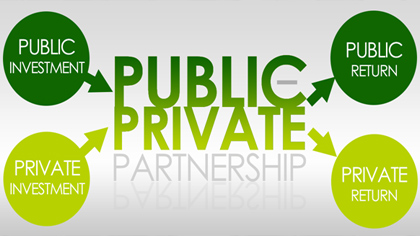
Public-Private Partnership (PPP)
 A Public-Private Partnership (PPP) is a cooperative arrangement between the public and private sectors, typically for long-term projects. Over the years, various governments worldwide have used PPPs to achieve specific objectives, such as infrastructure development and service delivery.
A Public-Private Partnership (PPP) is a cooperative arrangement between the public and private sectors, typically for long-term projects. Over the years, various governments worldwide have used PPPs to achieve specific objectives, such as infrastructure development and service delivery.
In a PPP, the private partner assumes the traditional public sector role of delivering services to the public, under conditions that are monitored either independently or by a government agency, depending on the nature of the service or asset. However, the ultimate responsibility for service provision remains with the public entity, even if the private partner is responsible for execution.
Key Elements of a Public-Private Partnership
- Strategic method of procurement
- Outcome coordination
- Value for money
- Shared risks and resources
- Formal arrangement between the public and private sectors
- Accelerated infrastructure development and faster project implementation

Types of Projects Under PPPs
PPPs can be used for a variety of infrastructure and service-related projects, including but not limited to:- Railway projects and related commercial developments
- Highways, expressways, bridges, tunnels, and interchanges
- Port infrastructure, including piers, wharves, and storage facilities
- Airport and air navigation services
- Power generation, transmission, and distribution
- Telecommunication networks and services
- Irrigation systems and related infrastructure
- Water supply, sewerage, and drainage systems
- Education and healthcare facilities
- Land reclamation and environmental development projects
- Industrial estates, tourism developments, and ecotourism
- Government buildings and housing projects
- Markets, slaughterhouses, and other related facilities
- Warehouses and post-harvest storage facilities
- Information technology and data infrastructure
- Public fish ports, ponds, and processing facilities
- Environmental and waste management infrastructure
- Non-rail mass transit systems and inland waterways
- Climate change mitigation and adaptation projects
Benefits of Public-Private Partnerships
Governments utilize PPPs for several reasons, including:- Private Sector Capital:
- Official development assistance is limited and subject to government priorities. In contrast, private sector funding is readily available and can supplement government budgets for large-scale projects.
- For major infrastructure projects, PPPs leverage private sector financial capital to accelerate construction and service delivery.
- Affordability:
- By using a PPP, governments reduce upfront spending as the costs are shared with the private sector. The private partner not only funds the project but also operates and maintains it, reducing long-term costs for the government.
- PPPs often secure the most cost-effective capital and resources for projects.
- Value for Money:
- Value for money is achieved when the project maximizes the benefit from services and goods provided, taking into account all costs, risks, and benefits throughout the project's life cycle.
- Risk Allocation:
- Risks are assigned to the party best equipped to manage or absorb them. Typically, the private sector handles life-cycle risks, while the government manages site risks and policy-related risks.
- Output Focus:
- PPP projects are subject to stringent preparation standards to ensure they are bankable and able to withstand scrutiny. This helps ensure that projects are completed on time and meet quality standards.
- Quality Assurance:
- The private partner is responsible for delivering quality services throughout the project. Payments are made only after meeting performance standards, with an independent consultant ensuring both parties adhere to contract terms.
- Encouragement of Innovation:
- PPPs benefit from private sector efficiency, specialization, and technological expertise, driving innovation and improving project outcomes.

